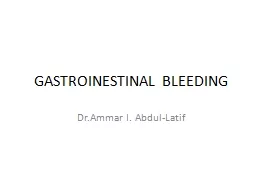

DrAmmar I Abdul Latif CLASSIFICATION OF GIBLEEDING UPPERampLOWER GIBLEEDING CAUSES OF UPPER GI BLEEDING CLINICAL PRESENTATION Significant GI bleeding typically manifests with some combination of ID: 919739
Download Presentation The PPT/PDF document "GASTROINESTINAL BLEEDING" is the property of its rightful owner. Permission is granted to download and print the materials on this web site for personal, non-commercial use only, and to display it on your personal computer provided you do not modify the materials and that you retain all copyright notices contained in the materials. By downloading content from our website, you accept the terms of this agreement.
Slide1
GASTROINESTINAL BLEEDING
Dr.Ammar
I. Abdul-
Latif
Slide2CLASSIFICATION OF G.I.BLEEDING
Slide3UPPER&LOWER G.I.BLEEDING
Slide4CAUSES OF UPPER G.I. BLEEDING
Slide5CLINICAL PRESENTATION
Significant GI bleeding typically manifests with some combination of:
Weakness, dizziness, lightheadedness, shortness of breath,
Postural changes in blood pressure or pulse, Cramping abdominal pain, and diarrhea
Slide6CLINICAL PRESENTATION
The characteristics of the bleeding may help to localize its source to the upper or lower GI tract. Patients with acute bleeding commonly have one of the following symptoms at presentation.:
1.
Hematemesis
:
The patient vomits bright red blood or material that resembles coffee grounds, representing partially digested blood. After exclusion of swallowed blood from the
nasopharynx
or the respiratory tract (
hemoptysis
), the source of bleeding is likely to be proximal to the ligament of
Treitz
Slide7CLINICAL PRESENTATION
2.
Melena
:
Black, tarry, usually foul-smelling stools are most often a manifestation of upper GI bleeding; however, a small bowel or proximal colonic source of bleeding may on occasion lead to
melenic
stools. Volumes as little as 50 to 100
mL
of blood in the stomach can result in
melena
.
3.
Hematochezia:
The passage of bright-red blood or maroon stools per rectum frequently indicates a lower GI source of bleeding. However, 10% to 15% of patients with acute severe
hematochezia
have an upper GI source of brisk bleeding. This group of patients commonly displays signs of hemodynamic instability
Slide8MANAGEMENT
Slide9MANAGEMENT-STABILIZATION
-Determine the severity of blood loss
-Vital signs with postural changes should be recorded immediately
:
.= If the systolic blood pressure drops more than 10 mm Hg or the pulse increases more than 10 beats per minute as the patient changes position from supine to standing, it is likely the patient has lost at least
800
mL
(15%) of circulating blood volume.
=Hypotension,
tachy
-
cardia
,
tachypnea
, and mental status changes in the setting of acute GI hemorrhage suggest the loss of at least 1500
mL
(30%) of circulating blood volume.
Slide10MANAGEMENT-STABILIZATION
The goals of resuscitation
are to :
-Restore the normal circulatory volume .
-Prevent complications from red blood cell loss, such as cardiac, pulmonary, renal, or neurologic consequences.
=At least two large-bore intravenous catheters are used to administer isotonic solutions (e.g., lactated Ringer’s solution,0.9%
NaCl
), and blood products if indicated.
= If the patient is in shock, central venous access should be established
Slide11MANAGEMENT-STABILIZATION
=Recent randomized trials and a retrospective review suggest that use of a
lower hemoglobin threshold of 7 g/
dL
, rather than a more liberal level of 9 g/
dL
, results in improved mortality rates, lower total transfusion requirements, and lower rates of
rebleeding
in both peptic ulcer bleeding and
variceal
bleeding
in patients in whom early endoscopy (5 hours) is available.
=
If coagulation studies are abnormal,
as is commonly observed in cirrhotic patients, fresh- frozen plasma, platelets, or both may be required to control ongoing hemorrhage.
Slide12Initial Evaluation-History
1.
The nature of the bleeding:
melena
,
hematemesis
,
hematochezia
, or occult blood. A digital rectal examination is essential for determination of stool color and identification of anal fissures or rectal
neoplasms
.
2.
The duration of GI bleeding
, which helps dictate the appropriate pace of the evaluation to determine the bleeding source
3.
The presence or absence of abdominal pain
; for example,
hematochezia
caused by
diverticula
or
angiodysplasia
typically is painless, but
hematochezia
due to intestinal ischemia it is often accompanied by abdominal pain.
4.
Other associated symptoms
, including fever, urgency or
tenesmus
, recent change in bowel habits, and weight loss
5.
Relevant past medical and surgical history
, including a history of prior GI bleeding, abdominal surgery (prior abdominal aorta repair should raise suspicion for an
aortoenteric
fistula), radiation therapy (radiation
proctitis
), major organ diseases (including cardiopulmonary, hepatic, or renal disease), inflammatory bowel diseases, and recent
polypectomy
(post-
polypectomy
bleeding).
Slide13Initial Evaluation-Physical Examination
The physical examination must include an assessment of vital signs, cardiac and pulmonary examinations, and abdominal and digital rectal examinations
Slide14Initial Evaluation-
laboratory examination
The initial laboratory examination should include a complete blood cell count, blood typing and cross-matching, and measurements of serum electrolytes, blood urea nitrogen,
creatinine
, and coagulation factors.
The first
hematocrit
measurement may not reflect the degree of blood loss, but it will decrease gradually to a stable level over 24 to
48 hours.
Slide15THE ROLE OF ENDOSCOPY
Slide16Evaluation-Endoscopy
Slide17Spurting blood vessel
Slide18Evaluation-Endoscopy
Slide19Treatment-Non- variceal
Bleeding
Slide20Thermal Treatment of bleeding DU with
heatprobe
Slide21Mechanical Treatment of Bleeding Vessel
Clipping of bleeding vessel
Vesible
vessel
Slide22BleedingEsophsgeal
varices
BleedingEsophsgeal
varices
Esophsgeal
varices
Slide23BleedingEsophsgeal
varices
Slide24Variceal
Haemorrhge
Slide25Slide26Treatment of UGIB-Summary
VARICEAL
NON-VARICEAL
MODALITY OF TREATMENT
Somatostatin or it's
analogue
Terlipressin
I.V. PPI
Medical
Tx
Sclerotherapy
Banding
Mechanical(N/S-adrenalin
injection,Haemoclip
)
Thermal
(
Heatprobe,Argon
Endoscopic
Tx
Sengstaken
tube
Hemospray
Rescue
Tx
.
TIPSS
Angiograghy-Embolization
Interventional Radiology
Tx
.
Porto-systemic shunt
Ligation of bleeding vessel
Surgical
Tx
.
Slide27Slide28Slide29Slide30Capsule endoscopy
Capsule endoscopy
Angiodyslasia
of small bowel
Slide31Slide32Slide33Slide34